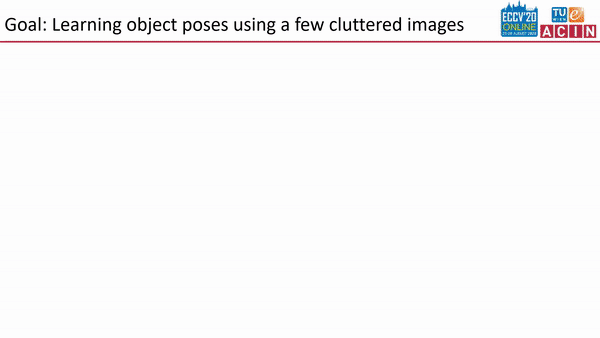An official implementation of the paper, Neural Object Learning for 6D Pose Estimation Using a Few Cluttered Images, ECCV 2020 Spotlight, https://arxiv.org/abs/2005.03717
The best way of running the code is using a nvidia-docker container
- Docker + Nvidia-docker (https://github.com/NVIDIA/nvidia-docker)
- NVidia driver >=418.56
- CUDA = 10.1
- The requirments below are automatically installed when building a docker container
- Tensorflow == 2.1.0
- Dirt (https://github.com/kirumang/dirt.git), forked from (https://github.com/pmh47/dirt)
- See python requirements in requirements.txt
If you use this code, please cite the following
@InProceedings{Park_2020_ECCV,
author = {Park, Kiru and Patten, Timothy and Vincze, Markus},
title = {Neural Object Learning for 6D Pose Estimation Using a Few Cluttered Images},
booktitle = {European Conference on Computer Vision (ECCV)},
month = {Aug},
year = {2020}
}
- git clone
git clone --recurse-submodules https://github.com/kirumang/NOL.git - Build Dockerfile
bash docker_build.sh - Edit docker_run.sh
vim docker_run.sh- Set
data_mount_argto link dataset folders with the docker container - E.g., -v <path_to_dataset_local>:<path_to_dataset_container>
- Set
- Start the container
bash docker_run.sh - Test using the example script (Rendering an image of the cracker_box in SMOT)
python3 examples/NOL_rendering_one.py cfg_camera/camera_SMOT.json sample_data/obj_01.hdf5
The code is ready to run if you can see a rendered image in the folder ./result/obj_01/,
with the following message.
Generated: ./results/obj_01/0000.png
The result image should look like this,
This is an example code for rendering an object from various view points
The variable, max_iter, can be reduced to increase the rendering speed
python3 examples/NOL_rendering.py <path/to/camera_cfg (.json)> <path/to/data (.hdf5)> <path/to/target (default: /result/filename/)>
- From the entire training set, a number of images is sampled as source images
- Please refer to the paper for more details of the process
- Preprocess for the LineMOD objects: the result file (.hdf5) will be saved in
sample_data/linemodfolder Link to the LindMOD dataset @ BOP Challenge
python3 data_processing/process_LineMOD_BOP.py [path/to/bop/lm] [obj_name e.g., obj_01,obj_02,...]
- Preprocess for the SMOT objects: the result file (.hdf5) will be saved in
sample_data/smotfolder.
- Download and extract the SMOT dataset, Link to the SMOT dataset page
- Run the sampling script (the ICP option is activated by default)
python3 data_processing/process_SMOT.py [path/to/smot] [obj_name e.g., obj_01,obj_02,...] [icp=yes(1)/no(0),default=1]
a data file (.hdf5) should be created to render a new object from source images
- Essential components and keys for N source images
- "vertices_3d": 3D vertices (Vx3, numpy array)
- "faces": face indices (Fx3, numpy array)
- "images": cropped patches of source images (Nx256x256x3, numpy array)
- "bboxes" : bboxes, defined in the original images, where the patches are cropped from (Nx4, numpy array, [v1,h1,v2,h2])
- e.g., if a patch of the object is cropped from (100,200) - (150,400)
- images[0] = a resized image of the region (100,200) - (150,400)
- bboxes[0] = [100,200,150,400]
- "poses" : object poses (transformation matrix) in the source images (Nx4x4, numpy array)
- Save the components to a hdf5 file
train_data = h5py.File(fn, "w")
train_data.create_dataset("vertices_3d",data=np.array(vertices_3d))
train_data.create_dataset("faces",data=np.array(faces))
train_data.create_dataset("images",data=np.array(input_imgs))
train_data.create_dataset("poses",data=np.array(poses_))
train_data.create_dataset("masks",data=np.array(masks))
train_data.create_dataset("bboxes",data=np.array(bboxes))
train_data.close()
- Define camera config (.json) file
- See
cfg_camera/camera_Default.jsonfor a reference
- The paper should be cosidered the main reference for this work. All the details of the algorithm and the training are reported there
- Feel free to contact us when a new function is required for custom images
- Kiru Park - email: park@acin.tuwien.ac.at / kirumang@gmail.com

